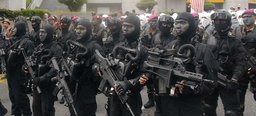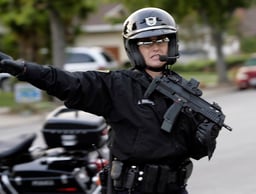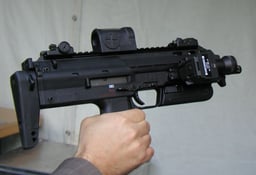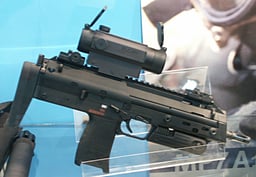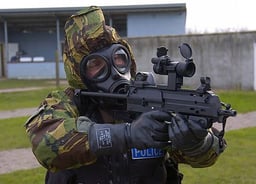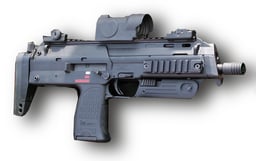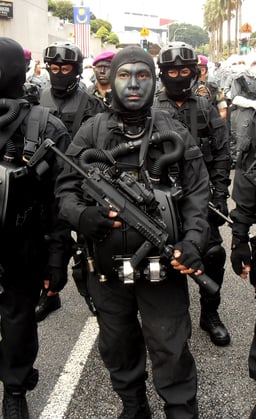Heckler & Koch UCP
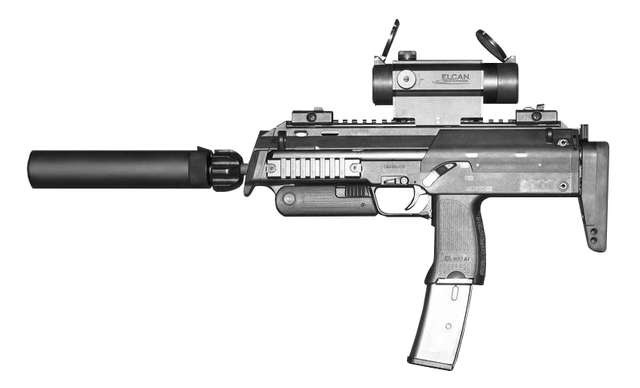
Heckler & Koch UCP

| Heckler & Koch MP7 | |
|---|---|
| Type |
|
| Place of origin | Germany |
| Service history | |
| In service | 2001–present |
| Used by | 20+ countries (see Users) |
| Wars |
|
| Production history | |
| Manufacturer | Heckler & Koch |
| Produced | 1999–present |
| Specifications | |
| Mass | |
| Length | 638 mm (25.1 in) stock extended / 415 mm (16.3 in) stock collapsed[3] |
| Barrel length | 180 mm (7.1 in)[4] |
| Width | 51 mm (2.0 in)[3] |
| Height | 169.5 mm (6.7 in)[3] |
| Cartridge | Calibre 4.6×30mm |
| Action | Gas-operated, short stroke piston, rotating bolt |
| Rate of fire | 950 RPM |
| Muzzle velocity | 735 m/s (2,411 ft/s) (Fiocchi CPS Black Tip ammunition) |
| Effective firing range | 200 m (660 ft)[5][6][7] |
| Feed system | 20-, 30- or 40-round detachable box magazine |
| Sights | Tritium-illuminated flip-up night sights; handgun and rifle sights (adjustable) |
The Heckler & Koch MP7 (Maschinenpistole 7) is a personal defence weapon (PDW) chambered for the HK 4.6×30mm armor-piercing cartridge designed by German defense manufacturer Heckler & Koch. It was designed together with the new cartridge to meet NATO requirements published in 1989, as these requirements call for a compact PDW-class firearm, with a greater ability to defeat body armors than the current submachine guns using conventional pistol cartridges.
The proliferation of high-quality body armor has begun to make guns that fire pistol ammunition (such as Heckler & Koch's earlier MP5 submachine gun and USP pistol) ineffective. In response to this trend, Heckler & Koch designed the MP7 (along with the cancelled UCP pistol, which uses the same ammunition) to penetrate body armor while being small enough to be used in place of either a pistol or a submachine gun.[8][9][11]
| Heckler & Koch MP7 | |
|---|---|
| Type |
|
| Place of origin | Germany |
| Service history | |
| In service | 2001–present |
| Used by | 20+ countries (see Users) |
| Wars |
|
| Production history | |
| Manufacturer | Heckler & Koch |
| Produced | 1999–present |
| Specifications | |
| Mass | |
| Length | 638 mm (25.1 in) stock extended / 415 mm (16.3 in) stock collapsed[3] |
| Barrel length | 180 mm (7.1 in)[4] |
| Width | 51 mm (2.0 in)[3] |
| Height | 169.5 mm (6.7 in)[3] |
| Cartridge | Calibre 4.6×30mm |
| Action | Gas-operated, short stroke piston, rotating bolt |
| Rate of fire | 950 RPM |
| Muzzle velocity | 735 m/s (2,411 ft/s) (Fiocchi CPS Black Tip ammunition) |
| Effective firing range | 200 m (660 ft)[5][6][7] |
| Feed system | 20-, 30- or 40-round detachable box magazine |
| Sights | Tritium-illuminated flip-up night sights; handgun and rifle sights (adjustable) |
Design details
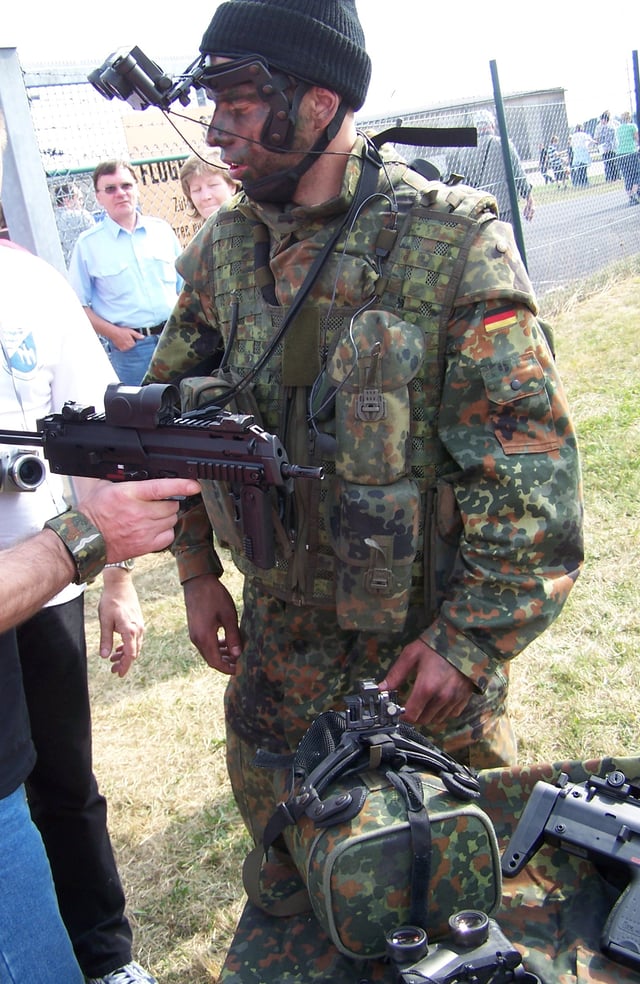
A German Army soldier demonstrates the MP7A1 of the IdZ program
The MP7 uses a short-stroke piston gas system as used on H&K's G36 and HK416 in place of a blowback system traditionally seen on sub-machine guns including those by H&K.[12] The 4.6×30mm ammunition is exclusive to the gun and offers low recoil.[8][9] This ammunition is unique among submachine guns in that the bullet is made almost entirely of a hardened steel penetrator instead of softer copper or lead.
The MP7 allows a conventional 20-, 30- or 40-round box magazine to be fitted within the pistol grip (the 20-round magazine is comparable in size to a 15-round 9×19mm magazine, while the 40-round magazine compares to a 30-round 9×19mm magazine). It features an ambidextrous fire selector, bolt catch lever and magazine release. It has an extendable stock and a folding front grip (MP7 and MP7A1 variants, MP7A2 lacks the folding front grip); it can be fired either one-handed or two-handed.[8][9] It is compact and light, due to the use of polymers in its construction.
The MP7 has a cyclic rate of fire of 950 rounds per minute (RPM).
Ammunition
The MP7's specially designed armor piercing (AP) high velocity rounds consist of either copper-plated solid steel (DM11), alloy plated steel jacket (DM21) or copper-alloy-jacketed lead core projectiles (Fiocchi FMJ ZP). Standard AP high velocity DM11 (Ultimate Combat) round with a 2.0 g (31 gr) projectile has a muzzle velocity of 720 m/s (2,362 ft/s) and has a muzzle energy of 506 J (373 ft-lbf).[13] The DM11 round penetrates the NATO CRISAT target (20 layers of kevlar with 1.6 mm titanium backing) at 200 m.[14] The round has a small diameter, allowing for redoubling penetration capability and high capacity in a very small magazine.[15]
VBR of Belgium produces a 4.6×30mm two-part controlled fragmenting projectile that is claimed to increase the content of the permanent wound cavity and double the chance to hit a vital organ.[8][9][16] Heckler & Koch claims that the CPS Black Tip ammunition made by Fiocchi has a muzzle energy of approximately 525 J, which would be comparable to 9×19mm Parabellum rounds.[17][18]
Accessories
The MP7 features a full-length, top-mounted Picatinny rail that comes as standard with folding fore and rear iron sights attached. When the sights are folded flat, they resemble Patridge style open sights. Folded up, they feature aperture sights. The sights can easily be removed by loosening a single screw and lifting them off. It can fit additional rails on the sides of the barrel, which allow it to mount commercial optical sights (telescopic and red dot sights), laser aiming modules (LAM), and tactical flashlights. It can also accept a suppressor, and its tailor-made suppressor does not interfere with its accuracy or rate of fire.
Variants
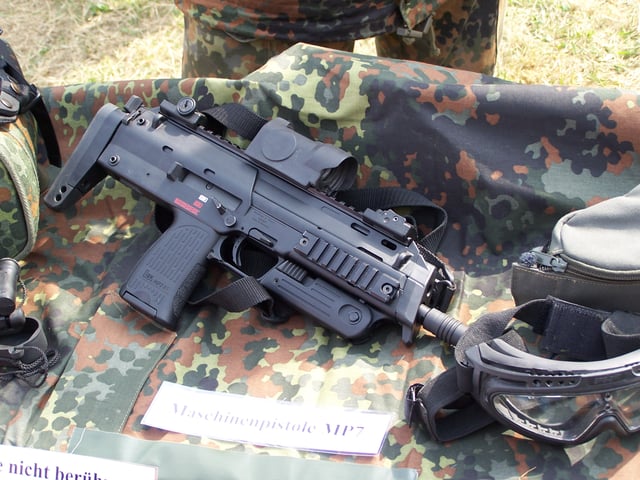
A recent production MP7A1 (note the safety trigger) with a Zeiss RSA reflex red dot sight on display as part of Germany's IdZ program.[19]
PDW: The first prototype was shown in 1999 and was designated as the 'PDW' (Personal Defense Weapon). It had a short Picatinny rail on the top and a smooth pistol grip surface.
MP7: In 2001 it was designated as the 'MP7' and went into production. Changes includes a full length Picatinny rail, a thick curved stock and an anti-slide surface on the pistol grip much like the HK USP. It also features a folding iron sights mounted on the Picatinny rail and the button to fold the foregrip was made larger for easier operation.
MP7A1: In 2003 its designation was changed to 'MP7A1' and featured a redesigned pistol grip with a different surface and curved shape, a smaller stock with a straight buttpad, side mounted picatinny rails as standard and the folding iron sights were made more compact. The weapon was made slightly longer, but because the stock was shortened, the overall length did not change. The stock is also able to be locked into 3 positions. Recent MP7A1 models have a trigger safety similar to a Glock pistol; the middle section of the trigger must be pulled first before the outer part will move. This helps to stop accidental discharges if the trigger is bumped.[8][9]
MP7A2: A variant without the folding front grip but features a Picatinny rail to mount various grips in line with the user's preference.
MP7-SF: A semi-automatic only variant of the MP7 which is currently used by the Ministry of Defence Police in the United Kingdom.
Users
| Country | Organization name | Model | Quantity | Date | Reference |
|---|---|---|---|---|---|
| Special Operations Battalion (Albania) | − | − | − | [9][20] | |
| Special Intervention Detachment and Special Intervention Group | − | − | − | [21] | |
| Western Australia Department of Corrective Services Emergency Support Group | − | − | − | [9][22] | |
| Einsatzkommando Cobra (EKO Cobra) of the Austrian Federal Ministry of the Interior | − | − | − | [9][23] | |
| 1st Para Commando Battalion Bangladesh Army | − | − | − | ||
| Special Forces Regiment of the Royal Brunei Armed Forces | MP7A1 | − | − | [24] | |
| Special Group of Intervention (GEI) of the Mossos d'Esquadra | _ | _ | _ | ||
| Police of the Czech Republic - PDW of ordinary police officers - guns are locked in a special compartment of ordinary police cars' front doors | MP7A1 | − | 2012 | [25] | |
| Unit 777 - Egyptian military counter-terrorism and special operations | -- | -- | -- | ||
| ESTSOF | − | − | − | [26] | |
| French special forces, DGSE SA, GIGN | MP7A1 | − | − | [27][28] | |
| German Army | − | − | [8][9][29] | ||
| Grenzschutzgruppe 9 (GSG 9) counter-terrorism group of the German Federal Police | − | − | [9][30] | ||
| SEK SWAT police unit (state police) of several German states | − | − | − | [9][31] | |
| Baden-Württemberg Police | 3000 | [32] | |||
| Ministry of Internal Affairs | − | − | − | [33][34] | |
| 13th Special Operations Command special forces of the Hellenic Army | -- | -- | -- | ||
| Komando Pasukan Khusus (KOPASSUS) special forces of the Indonesian Army | − | − | − | [35] | |
| Garda; Special Detective Unit, Emergency Response Unit, Regional Support Unit, National Bureau of Criminal Investigation | MP7A1 | − | 2006 | [8][36][37] [9][38] | |
| 9th Parachute Assault Regiment | − | − | − | [9] | |
| N.O.C.S. of Polizia di Stato | − | − | − | [9] | |
| Japanese Special Forces Group | − | − | − | [39] | |
| Royal Guards, Special forces 71 Antiterrorism Unit | − | − | − | [9][40] | |
| Pasukan Khas Laut (PASKAL) counter-terrorism group of the Royal Malaysian Navy | MP7A1 | − | 2006 | [9][41] | |
| Pasukan Gerakan Khas (PGK) counter-terrorism divisions of the Royal Malaysia Police | − | 2007 | [8][9] | ||
| GIPM | − | 2013 | |||
| Norwegian Armed Forces | 6,500 | 2007 | [8][9][42] | ||
| Norwegian Police Security Service (PST) and the Royal Police Escort | − | − | [43] | ||
| − | − | − | − | [9][40] | |
| Republic of Korea National Police Agency SWAT | − | − | − | [8][9] | |
| Presidential Security Service | − | − | − | [44] | |
| SRI Brigada Antitero | MP7A1 | − | − | [45] | |
| Serbian Special Forces | MP7A1 | [46] | |||
| SOG | Kpist MP 7 | − | |||
| Spetsnaz special forces unit of the Russian Army | MP7A1 | [47] | |||
| Ministry of Defence Police and Metropolitan Police | MP7-SF | − | − | [8][9][48] | |
| United States Naval Special Warfare Development Group | − | − | − | [9][49] | |
| Sunnyvale Department of Public Safety in California | MP7A1 | − | − | [9][50][51] | |
| Pontifical Swiss Guard | − | − | [52] |




